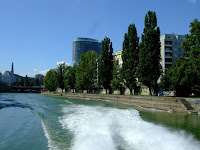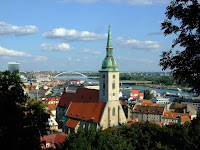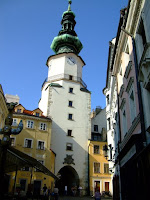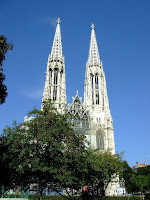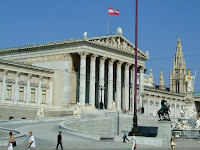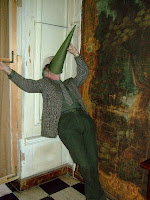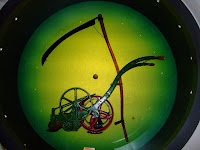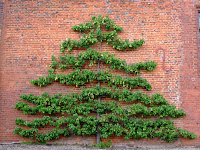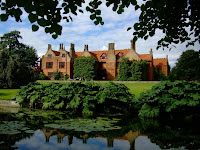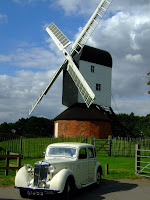
15C and rain in London? 30C and sun in Vienna? It was a tough choice but having woken to glorious sun in Vienna this morning, we decided to stay and explore the city.
Our hotel was just across the river from the centre of Vienna so we made our way to Stephansplatz to have a look at St Stephan's Cathedral with its attractive patterned roof. Along the Graben we checked out another local tourist attraction, the underground loos designed by Aldof Loos and the beautiful baroque Peterskirche with its wonderful frescoes.

An unusual extra in this church are two glass-fronted shrines enclosing the bones of two martyrs brought from the catacombs of Rome in 1730, The bones are clothed in the style of the period with cut-outs in places so that the bones can be seen. All quite macabre really.
There was obviously lots about to happen in the gardens in the Hofburg as people we setting up f
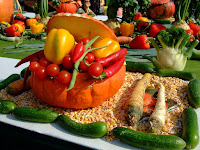
or a country-comes-to-the-city festival of some sort but we wandered on through the museum quarter and down to the Naschmarkt that, unlike the festival area, was in full flow with thongs of people jostling past the stalls. Exiting the far end we checked the map and found we still had about 7 km to go to the Shloss Schonbrunn, that earlier information had indicated was only 20 minutes away - clearly not on foot.

Time for the U-bahn and, fortunately, the station we were near was on the direct line to Shloss Schonbrunn. When the palace was built it was far enough away from Vienna to be the summer palace, now it is a short ride on the U-bahn.
After carefully considering which ticket combination to purchase we settled on the Classic Pass which afforded us the extended palace tour, entrance to the Privy Garden, the Gloriette at the top of the hill, the Maze and the Apple strudel show.

The strudel show was well worth it; watching the chef spin a smallish lump of dough out to an area that wasn't much short of a square metre and so thin you could read through it, was quite amazing.
The palace and formal gardens are quite stunning and wandering though the rows of trees, all meticulously manicured into vertical walls where they fronted a path, allowed us to stumble across all

manner of extra delights that did not seem to be mentioned in the information we had been given.
Maire Antoinette was a famous daughter from this palace, Napolean's son was "confined to barracks" here for his short life to keep him out of the political arena, Mozart played here for the Empress when he was 6 and Kruschev

and Kennedy first met here for a Summit in 1961, so it has seen a fair chunk of history.
On our way back to the hotel we enjoyed the tail-end of the afternoon with a cold drink and a sun-lounger on a "beach" of golden sand on the banks of the river.
 Vienna arrived and we joined it for the rest of the trip to Budapest. If yesterday's trip seemed fast, it was nothing compared to the hydrofoil. They only seem to exist now in ex-communist countries and this one cruised at between 65 and 69kph all the way, apart from the time in the only lock on the river. This lock is probably the largest we have been in so far and certainly the greatest level change, approximately 25m.
Vienna arrived and we joined it for the rest of the trip to Budapest. If yesterday's trip seemed fast, it was nothing compared to the hydrofoil. They only seem to exist now in ex-communist countries and this one cruised at between 65 and 69kph all the way, apart from the time in the only lock on the river. This lock is probably the largest we have been in so far and certainly the greatest level change, approximately 25m. The Danube was certainly blue and the first touches of autumn were beginning to colour the trees on the banks as we raced downstream. There was not a lot to note as we travelled, the odd town or two, until we got to the famed "Danube Bend", a place were the Danube makes a fairly decided change from flowing east to flowing south. The two notable towns on the bend are Esztergom and Visegrad.
The Danube was certainly blue and the first touches of autumn were beginning to colour the trees on the banks as we raced downstream. There was not a lot to note as we travelled, the odd town or two, until we got to the famed "Danube Bend", a place were the Danube makes a fairly decided change from flowing east to flowing south. The two notable towns on the bend are Esztergom and Visegrad. From there it is a relatively short run into the centre of Budapest where we disembarked and set off to find the tourist office that had handled our booking and then the accommodation itself.
From there it is a relatively short run into the centre of Budapest where we disembarked and set off to find the tourist office that had handled our booking and then the accommodation itself. We had booked a room in a private apartment and were greeted by a lovely old couple who spoke as much English as we spoke Hungarian - none. They were a delight to stay with though, as were treated to home baking and fruit from what we suppose was their allotment. Her strudel, with their own apples, was better than any we purchased.
We had booked a room in a private apartment and were greeted by a lovely old couple who spoke as much English as we spoke Hungarian - none. They were a delight to stay with though, as were treated to home baking and fruit from what we suppose was their allotment. Her strudel, with their own apples, was better than any we purchased. Although the accommodation was ‘homely’ with some fairly odd-plumbing, the location was superb; we were about 100m from the only station that services all three Metro lines, a short walk to the square, the river and all the central sites and amenities.
Although the accommodation was ‘homely’ with some fairly odd-plumbing, the location was superb; we were about 100m from the only station that services all three Metro lines, a short walk to the square, the river and all the central sites and amenities.

